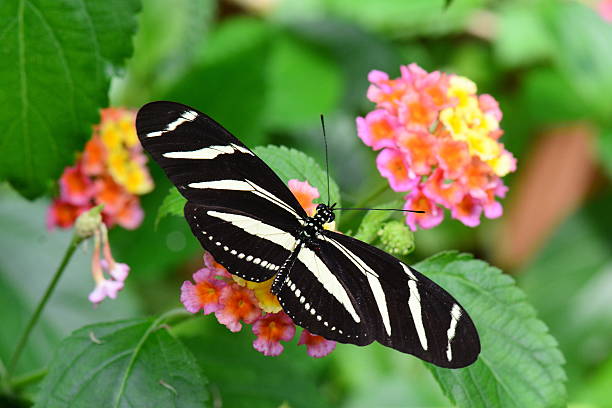ANIMAL: Zebra Longwing Heliconius charithonia Type of Animal: Brush-Footed Butterfly Habitat: Tropical/subtropical hammocks, tropical/subtropical thickets, shrubby thickets, forest margins, forests, open areas adjacent to forests, butterfly gardens, suburban yards, parks, edge habitats, fields, coastal woodlands Location(s): Found from C & S US through Caribbean & Mexico all the way through South America Appearance: Adults have elongated black wings w/ narrow white & yellow stripes on dorsal side & lighter black w/ red spots on ventral side, long black antennae. Caterpillars white w/ black spots & numerous black spikes Food/Diet: Adults eat nectar & pollen. Caterpillars eat passionflower plants. Status in Wild: Stable Conservation: Breeding in butterfly gardens, zoos, aquariums, & museums Lifestyle: Usually found in groups of 30-60 butterflies Additional Info: Called: Male Female Young: Caterpillar Group: Flutter Gestation: 4-8 days Life Span: 7 weeks-6 months Body Length/Wingspan: Male: 3 in Female: 3.5 in Young: 1 in Main predators are birds, lizards, amphibians, predatory insects, & mammals. Also called Zebra Heliconian. Females lay eggs singly or in clusters on passionflower plants. Eggs hatch after 4-8 days. Caterpillar stage lasts 2-3 weeks, in which they go through 5 instars (development phases)-they molt exoskeleton after 1st 4. After 5th instar, they pupate on passionflower plants. Pupa/chrysalis stage lasts 5-10 days. After this stage, they transform into butterflies. Butterflies can live as long as 5 months, due to also feeding on pollen as they feed on nectar. They can also breed more than once. After butterflies collect enough pollen, they’ll regurgitate digestive enzymes onto pollen mass, breaking it down into digestible, protein-rich supplement, which aids in production of eggs/sperm, contributing to longevity. Female pupae have distinct scent that adult males can distinguish & once they locate chrysalis, they will repeatedly visit & perch on top of it. Often multiple males gather on 1 chrysalis before female even emerges. This is known as pupal mating & sometimes, pupal rape. After male mates w/ female, he applies chemical to her which helps repel other males. Pollen feeding enables them to synthesize chemicals making them toxic to would-be predators. Caterpillars evade passionflower plants’ trichomes by biting them off or laying silk mats over them. Use eyes to help distinguish conspecifics from cospecifics. They roost at same sites every night. Pheromones play important role in courtship & breeding. Fun Fact(s): State butterfly of Florida. Coloration of both caterpillars & adults signify that they’re poisonous to would-be predators. Adults often display coloration synchronously.
